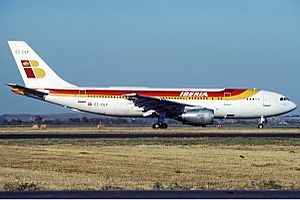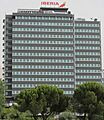Iberia (airline) facts for kids

An Iberia Airbus A350-900
|
|
| Founded | 28 June 1927 |
|---|---|
| Commenced operations | 14 December 1927 |
| AOC # | ES.AOC.001 |
| Hubs | Madrid–Barajas Airport |
| Frequent-flyer program | Iberia Club (Part of the Avios Loyalty program) |
| Alliance | Oneworld |
| Subsidiaries |
|
| Fleet size | 92 |
| Destinations | 130 |
| Parent company | International Airlines Group |
| Headquarters | Ciudad Lineal, Madrid, Spain |
| Key people |
|
| Revenue | |
| Net income | |
| Employees | 10,812 (2025) |
Iberia is Spain's main airline. It was started in 1927 and is based in Madrid. Iberia flies to many places around the world from its main airport, Madrid–Barajas Airport.
Iberia, along with its partners Iberia Regional and Iberia Express, is part of a larger company called International Airlines Group. Besides flying passengers and cargo, Iberia also takes care of plane maintenance, airport services, and even in-flight meals. Together, the Iberia Group flies to over 109 cities in 39 countries. They also reach 90 more places through special agreements with other airlines.
In 2010, Iberia and British Airways decided to merge. This created the third-largest airline group in the world at the time. The new company, International Airlines Group (IAG), started in 2011. Both airlines still use their own names and brands.
Contents
Iberia's Journey Through Time
Iberia, Compañía Aérea de Transportes, began on June 28, 1927. It started with money from a businessman named Horacio Echevarrieta and a German airline, Deutsche Luft Hansa. Flights officially began on December 14, 1927. The Spanish government first hired Iberia to carry mail between Madrid and Barcelona.
Early Flights and Growth
In 1929, Iberia joined a larger state-controlled airline group called CLASSA. This meant Iberia stopped flying on its own for a while. However, the name 'Iberia' was kept.
During the Spanish Civil War in 1937, Iberia started flying again. It used six Junkers Ju 52 planes from Deutsche Luft Hansa. These planes were bought by Iberia after the war. During the conflict, Iberia only flew within Spain and to Spanish areas in North Africa. After the war, in 1939, Iberia started its first regular international flight to Lisbon.
In 1940, the Spanish government gave Iberia the only right to fly within Spain for a few years. This helped the company grow into an important international airline. In 1944, the airline became owned by the government. Iberia then started buying planes from the United States, like the Douglas DC-3 and Douglas DC-4.
In 1946, Iberia made history by being the first airline to fly between Europe and South America after World War II. It used a Douglas DC-4 for flights between Madrid and Buenos Aires. This was the start of many flights connecting Latin America and Europe through Spain.
In 1954, Iberia began flying to New York City from Madrid. They used a new plane called the Lockheed L-1049 Super Constellation. This flight helped more American visitors come to Spain. In 1959, another Spanish airline, Aviaco, became part of Iberia.
Jet Age and Expansion
In the 1960s, Iberia started using jet planes. The first was the Douglas DC-8 in 1961. They also added smaller jets like the Sud Aviation Caravelle and McDonnell Douglas DC-9. By 1969, Iberia had 11 DC-8s for long flights.
In the early 1970s, even bigger planes like the Boeing 747 and Douglas DC-10 joined the fleet. This helped Iberia fly to even more cities, especially in Central America. By the mid-1970s, Iberia flew to almost all capital cities in Latin America.
In 1987, Iberia joined with other big airlines like Lufthansa and Air France to create Amadeus. This company helps travel agencies book flights. In the same year, Iberia planned to update its fleet with newer planes like the McDonnell Douglas MD-87 and Airbus A320.
Modern Era and Mergers
In the 1990s, Iberia tried to become a major airline in Latin America. It bought shares in several Latin American airlines, like Aerolíneas Argentinas and Viasa. However, these investments often faced challenges. Iberia also started its own frequent-flyer program, Iberia Plus, in 1991.
In 1996, Iberia launched its website, making it easier for people to book flights. In 1998, the company placed a very large order for 76 Airbus planes. The following year, it fully bought Aviaco.
In 2001, Iberia became a private company, and its shares were sold on stock exchanges. By 2002, Iberia had flown almost 500 million people in its history. In 2006, Iberia moved its main operations to Terminal 4 at Madrid - Barajas Airport, which gave it more space to grow.
In 2009, Iberia and British Airways announced plans to merge. This merger was completed on January 21, 2011, creating the International Airlines Group (IAG). Both airlines still fly under their own names.
In 2012, Iberia started a new low-cost airline called Iberia Express. This airline flies shorter routes from Madrid, helping passengers connect to Iberia's longer flights. In 2013, Iberia and Iberia Express moved their main offices to a new building in Madrid.
In 2023, Iberia announced it would start flying to Tokyo's Narita International Airport again in October 2024. These flights had been stopped in 2020 due to the COVID-19 pandemic.
Where Iberia Operates
Iberia works with other airlines to offer more flights.
Airline Partnerships
Iberia has special agreements with many airlines. This means you can book a flight with Iberia, but part of your journey might be on a plane from one of its partner airlines. This helps passengers travel to more places around the world.
Iberia is part of the Oneworld alliance, a group of major airlines that work together. This alliance includes airlines like American Airlines, British Airways, and Finnair.
Iberia also has "codeshare agreements" with many airlines. This means they share flights, allowing passengers to book tickets on one airline but fly on another. Some of these partners include:
- Aer Lingus
- airBaltic
- American Airlines
- Avianca
- Binter Canarias
- British Airways
- Boliviana de Aviación
- Bulgaria Air
- Cathay Pacific
- Copa Airlines
- El Al
- Evelop Airlines
- Finnair
- Japan Airlines
- LATAM Brasil
- LATAM Chile
- LATAM Ecuador
- Qatar Airways
- Royal Air Maroc
- Royal Jordanian
- Viva
- Volaris
- Vueling
- Widerøe
Iberia's Fleet of Aircraft
Iberia uses only Airbus planes for its flights.
Current Aircraft



As of May 2025, Iberia has 92 planes. Here are some of the types they fly:
- Airbus A319-100
- Airbus A320-200
- Airbus A320neo
- Airbus A321-200
- Airbus A321XLR (a newer, longer-range version)
- Airbus A330-200
- Airbus A330-300
- Airbus A350-900
Past Aircraft
Iberia has used many different types of planes over its long history. Some of these include:



- Airbus A300
- Airbus A340 (both -300 and -600 models)
- Boeing 727
- Boeing 747 (various models, also known as "Jumbo Jets")
- Boeing 757
- Douglas DC-3
- Douglas DC-8
- McDonnell Douglas DC-10
- Sud Aviation Caravelle
Inside Iberia's Planes
Iberia's planes usually have two main sections: Business Class and Economy Class.
Business Class
For flights within Spain and Europe, Business Class seats are the same as Economy, but the middle seat is left empty for more space. Business Class tickets also give you special perks at the airport, like faster check-in and access to airport lounges.
Business Plus
On long flights to places like the Americas and Southern Africa, Iberia offers Business Plus. These seats can lie flat, so you can sleep comfortably. They also come with many features found in international business classes.
Economy Class
For flights within Spain and Europe, Economy Class offers a "buy on board" service. This means you can buy snacks, drinks, and meals during your flight. On longer international flights, meals and drinks (except alcohol) are usually included in your ticket.
All of Iberia's newer long-haul planes have personal entertainment screens. This means you can watch movies, TV shows, or play games during your flight.
Important Events and Safety
Since 1939, there have been some accidents involving Iberia aircraft. Here are a few notable ones:
- In 1939, a Junkers Ju 52 plane was accidentally shot down near Gibraltar because it was mistaken for a German military plane.
- In 1948, a Douglas DC-3 crashed in bad weather, killing all 27 people on board.
- In 1965, a Convair 440 crashed into the sea near Tangiers, with 50 out of 53 people losing their lives.
- In 1972, Flight 602 crashed into a hill while approaching Ibiza Airport, killing all 104 people on board.
- In 1973, an Iberia Douglas DC-9 collided with another plane over France. The Iberia plane crashed, killing everyone on board.
- In 1983, an Iberia Boeing 727 crashed during takeoff in thick fog at Madrid Airport. It collided with another plane that had mistakenly taxied onto the runway. 51 people on the Iberia flight died.
- In 1985, Iberia Flight 610, a Boeing 727, crashed into a television antenna on a mountain while landing in Bilbao, killing 148 people.
- In 1996, Iberia Flight 6621 was hijacked on a flight from Madrid to Havana. The hijacker wanted to go to Miami. No one was hurt, and the plane landed safely in Havana.
- In 2001, Iberia Flight 1456 crashed on landing in Bilbao. No one died, but the plane was badly damaged.
- In 2007, Iberia Flight 6463, an Airbus A340, was badly damaged after sliding off the runway in Quito, Ecuador. No one was injured.
Images for kids
-
King Alfonso XIII of Spain after the first Iberia flight in 1927.
-
The crew of Iberia's first flight to Buenos Aires in 1946.
-
An Iberia Douglas DC-8-52 plane in Stockholm in 1969.
-
An Iberia Boeing 727–200 landing in London – Heathrow in 1978.
-
An Iberia Boeing 747–300 landing in Miami in 2005.
-
A Boeing 747-412 at Luxembourg Airport in June 2005.
See also
 In Spanish: Iberia (aerolínea) para niños
In Spanish: Iberia (aerolínea) para niños











